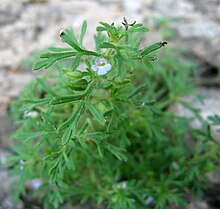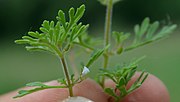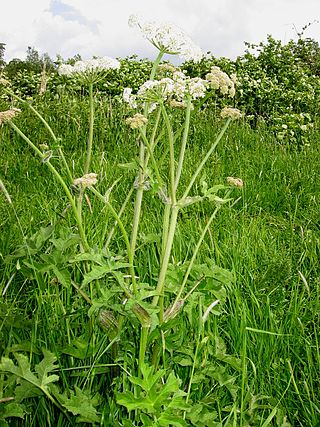
Heracleum sphondylium, commonly known as hogweed or common hogweed, is a herbaceous perennial plant in the carrot family Apiaceae, which includes fennel, cow parsley, ground elder and giant hogweed. It is native to most of Europe, western Asia and northern Africa, but is introduced in North America and elsewhere. Other common names include cow parsnip. The flowers provide a great deal of nectar for pollinators.
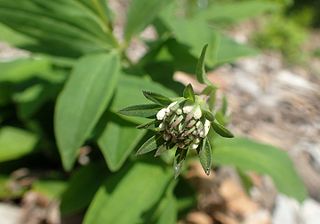
Marshallia is a genus of plants in the tribe Helenieae within the family Asteraceae. Marshallia is native to the southeastern and south-central United States. A common name applied to most species in the genus is Barbara's buttons.

Symphyotrichum lateriflorum is a species of flowering plant in the aster family (Asteraceae). Commonly known as calico aster, starved aster, and white woodland aster, it is native to eastern and central North America. It is a perennial and herbaceous plant that may reach heights up to 120 centimeters and widths up to 30 centimeters.

Symphyotrichum ascendens is a species of flowering plant in the family Asteraceae known by the common names western aster, long-leaved aster, and Rocky Mountain aster. Blooming July–September, it is native to western North America and can be found at elevations of 500–3,200 m (1,600–10,500 ft) in several habitats.

Balsamorhiza sagittata is a North American species of flowering plant in the tribe Heliantheae of the family Asteraceae known by the common name arrowleaf balsamroot. Also sometimes called Oregon sunflower, it is widespread across western Canada and much of the western United States.

Ribes lobbii is a shrubby, deciduous, shade-intolerant perennial dicot found on the western coast of North America. It was first described in 1876 by Asa Gray. The specific epithet was a dedication to the English plant collector William Lobb.

Madia glomerata is a species of flowering plant in the family Asteraceae known by the common name mountain tarweed.
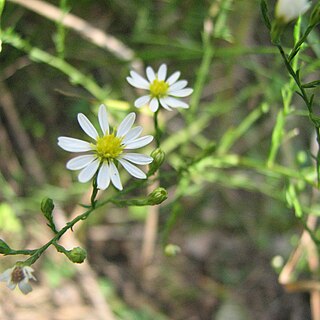
Symphyotrichum depauperatum, commonly known as serpentine aster or starved aster, is a rare species in the family Asteraceae adapted to serpentine barrens, an ecosystem with a high concentration of toxic metals in the soil. It has been found in Pennsylvania, Maryland, and on some diabase glades in North Carolina. It grows to 50 centimeters and has white ray florets surrounding a center of yellow disk florets.
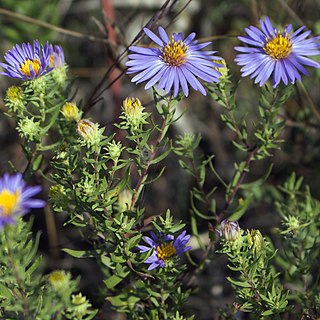
Symphyotrichum oblongifolium, commonly known as aromatic aster or oblong-leaved aster, is a species of flowering plant in the family Asteraceae and is native to parts of the eastern and central United States. It is an uncommon herbaceous perennial that reaches heights of 10–80 centimeters and blooms August–November with many flower heads in various shades of purple.
Ribes amarum is a species of currant known by the common name bitter gooseberry. It is endemic to California, where it is known from mountains, foothills, and canyons. Its habitat includes Chaparral.
Trichostema micranthum is a species of flowering plant in the mint family, known by the common name smallflower bluecurls.

Blephilia hirsuta, commonly known as hairy wood-mint or hairy pagoda plant, is a species of herbaceous perennial in the mint family Lamiaceae. It is native to eastern North America.
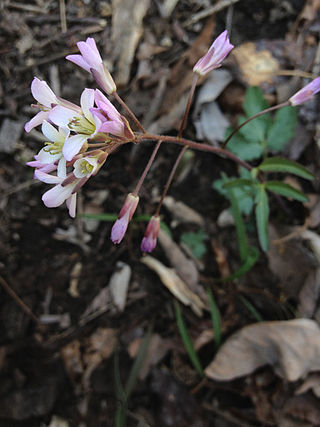
Cardamine angustata is a perennial forb native to the eastern United States, that produces white to pink or purple flowers in early spring.

Symphyotrichum oolentangiense, commonly known as skyblue aster and azure aster, is a species of flowering plant in the family Asteraceae native to eastern North America.

Arnica lanceolata is a North American species of flowering plant in the family Asteraceae, known by the common name clasping arnica or lanceleaf arnica. It has a disjunct (discontinuous) distribution in western North America and northeastern North America.

Aureolaria pedicularia, the fernleaf yellow false foxglove, fern-leaved false foxglove, or fernleaf false foxglove, is a parasitic plant of the family Orobanchaceae. Aureolaria pedicularia is native to parts of the eastern US, the Midwest, and adjacent Canada. This plant is known for its distinct leaf shape and overall plant size. The common names for Aureolaria pedicularia come from its fern-like leaves.

Cornus obliqua, the blue-fruited dogwood, silky dogwood, or pale dogwood, is a flowering shrub of eastern North America in the dogwood family, Cornaceae. It is sometimes considered a subspecies of Cornus amomum, which is also known as silky dogwood. It was first described in 1820 by Constantine Samuel Rafinesque. It is in the subgenus Kraniopsis.

Symphyotrichum patens, commonly known as late purple aster or spreading aster, is a perennial, herbaceous plant found in the eastern United States.

Penstemon albidus, commonly known as white penstemon, white-flower beardtongue, or Red-Line Beardtongue is a very widespread perennial flower of the mixed-grass and shortgrass prairies. Its natural distribution is from Manitoba and Alberta in Canada to Texas and New Mexico in the United States. The bright white flowers for which they are named are quite attractive to both bees and hummingbird moths.
Eriophorum tenellum is a species of flowering plant in the sedge family Cyperaceae.
